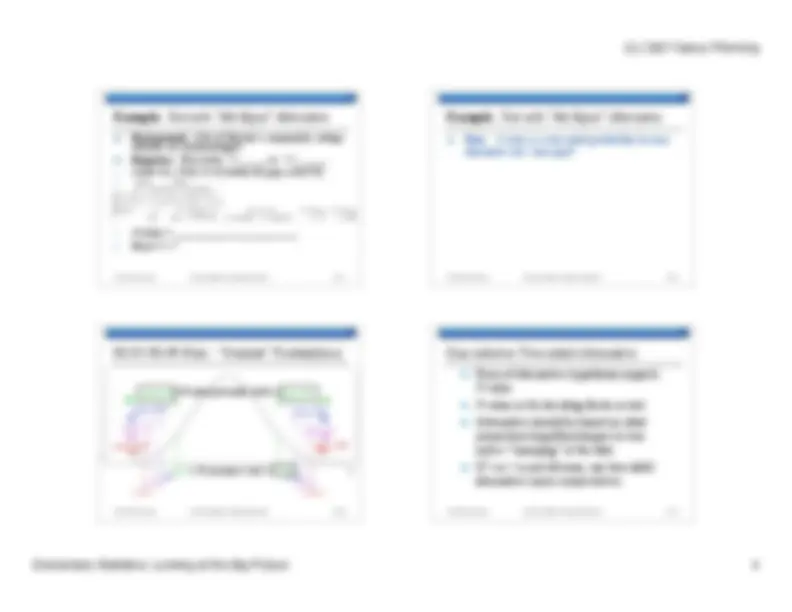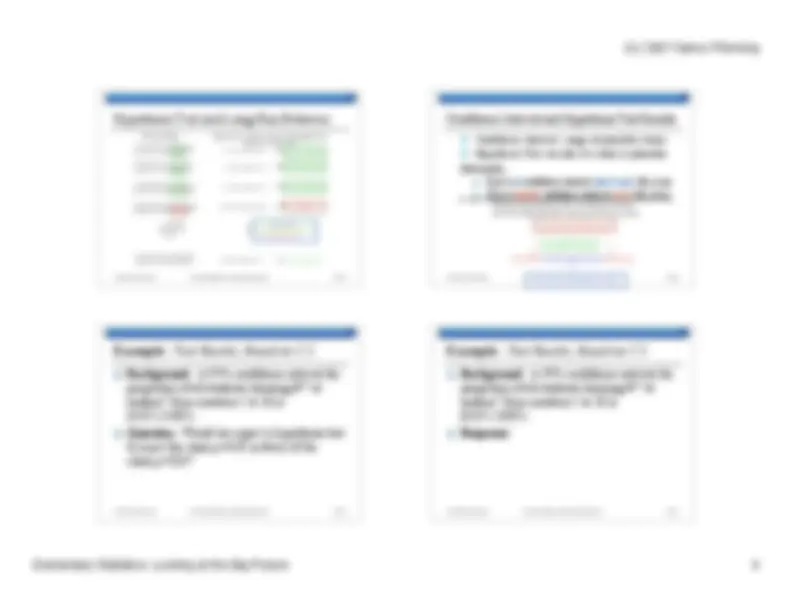








Study with the several resources on Docsity

Earn points by helping other students or get them with a premium plan


Prepare for your exams
Study with the several resources on Docsity

Earn points to download
Earn points by helping other students or get them with a premium plan
Community
Ask the community for help and clear up your study doubts
Discover the best universities in your country according to Docsity users
Free resources
Download our free guides on studying techniques, anxiety management strategies, and thesis advice from Docsity tutors
Material Type: Notes; Class: BASIC APPLIED STATISTICS; Subject: Statistics; University: University of Pittsburgh; Term: Spring 2007;
Typology: Study notes
1 / 10

This page cannot be seen from the preview
Don't miss anything!







(C) 2007 Nancy Pfenning Elementary Statistics: Looking at the Big Picture
Examples of Tests with 3 Forms of Alternative How Form of Alternative Affects Test When P -Value is “Small”: Statistical Significance Hypothesis Tests in Long-Run Relating Test Results to Confidence Interval (C) 2007 Nancy Pfenning Elementary Statistics: Looking at the Big Picture L23. 2
4 Stages of Statistics Data Production (discussed in Lectures 1-4) Displaying and Summarizing (Lectures 5-12) Probability (discussed in Lectures 13-20) Statistical Inference 1 categorical: confidence intervals, hypothesis tests 1 quantitative categorical and quantitative 2 categorical 2 quantitative (C) 2007 Nancy Pfenning Elementary Statistics: Looking at the Big Picture L23. 3
In a sample of 446 students, 0.55 ate breakfast.
State null and alternative hypotheses and : Null is “status quo”, alternative “rocks the boat”.
(C) 2007 Nancy Pfenning Elementary Statistics: Looking at the Big Picture L23. 5
(C) 2007 Nancy Pfenning Elementary Statistics: Looking at the Big Picture L23. 6
Background : 30/400=0.075 students picked #7 “at random” from 1 to 20. Want to test : p =0.05 vs.
. : p >0.05. Question: Is n large enough to justify finding P -value based on normal probabilities? (C) 2007 Nancy Pfenning Elementary Statistics: Looking at the Big Picture L23. 8
Background : 30/400=0.075 students picked #7 “at random” from 1 to 20. Want to test : p =0.05 vs.
. : p >0.05. Response: n = n (1- )=
30 and 370 both at least 10. (C) 2007 Nancy Pfenning Elementary Statistics: Looking at the Big Picture L23. 9
Note : Step 1 requires 3 checks: Is sample unbiased? (Sample proportion has mean 0.05?) Is population ≥ 10 n? (Formula for s.d. correct?) Are np o and n (1- p o) both at least 10? (Find or estimate P -value based on normal probabilities?)
(C) 2007 Nancy Pfenning Elementary Statistics: Looking at the Big Picture L23. 17
Background : 43% of Florida’s community college students are disadvantaged. Response: First write :_____ vs. : _____
Note: P -value is a two-tailed probability because alternative was “not equal” (C) 2007 Nancy Pfenning Elementary Statistics: Looking at the Big Picture L23. 20
1.70 just over 1.645 P-value just under 2(.05) (C) 2007 Nancy Pfenning Elementary Statistics: Looking at the Big Picture L23. 21
(C) 2007 Nancy Pfenning Elementary Statistics: Looking at the Big Picture L23. 23
Background : 43% of Florida’s community college students are disadvantaged. Question: Is % disadvantaged at Florida Keys (169/356=47.5%) unusually high? (C) 2007 Nancy Pfenning Elementary Statistics: Looking at the Big Picture L23. 25
Background : 43% of Florida’s community college students are disadvantaged. Response: Now write :______ vs. :_______
(C) 2007 Nancy Pfenning Elementary Statistics: Looking at the Big Picture L23. 27
(C) 2007 Nancy Pfenning Elementary Statistics: Looking at the Big Picture L23. 33
Background : Consider our prototypical examples: Are random number selections biased? P -value=0. Do fewer than half of commuters walk? P -value=0. Is % disadvantaged significantly different? P -value=0. Is % disadvantaged significantly higher? P -value=0. Question: What conclusions did we draw, based on those P -values? (C) 2007 Nancy Pfenning Elementary Statistics: Looking at the Big Picture L23. 35
Background : Consider our prototypical examples: Are random number selections biased? P -value=0. Do fewer than half of commuters walk? P -value=0. Is % disadvantaged significantly different? P -value=0. Is % disadvantaged significantly higher? P -value=0. Response: (Consistent with 0.05 as cut-off ) P -value=0.011Reject? ___ P -value=0.299 Reject? ___ P -value=0.088Reject? ___ P -value=0.044Reject? ___ (C) 2007 Nancy Pfenning Elementary Statistics: Looking at the Big Picture L23. 36
if no other info is provided if chain is enjoying considerable profits; owners are eager to pursue new ventures if chain is in financial difficulties, can’t afford losses if unsuccessful due to too few grads (C) 2007 Nancy Pfenning Elementary Statistics: Looking at the Big Picture L23. 38
if no other info is provided: use ___ if chain is enjoying considerable profits; owners are eager to pursue new ventures: use ___ if chain is in financial difficulties, can’t afford loss if unsuccessful due to too few grads: use ___
(C) 2007 Nancy Pfenning Elementary Statistics: Looking at the Big Picture L23. 39
Statistically significant data: produce P -value small enough to reject. z plays a role: Reject if P -value small; if | z | large; if… Sample proportion far from Sample size n large Standard deviation small (if is close to 0 or 1) (C) 2007 Nancy Pfenning Elementary Statistics: Looking at the Big Picture L23. 40
(C) 2007 Nancy Pfenning Elementary Statistics: Looking at the Big Picture L23. 41
Probability is cut-off
(C) 2007 Nancy Pfenning Elementary Statistics: Looking at the Big Picture L23. 42
(C) 2007 Nancy Pfenning Elementary Statistics: Looking at the Big Picture L23. 48
(C) 2007 Nancy Pfenning Elementary Statistics: Looking at the Big Picture L23. 50
(C) 2007 Nancy Pfenning Elementary Statistics: Looking at the Big Picture L19. 51
Examples with 3 forms of alternative hypothesis Form of alternative hypothesis Effect on test results When data render formal test unnecessary P -value for 1-sided vs. 2-sided alternative Cut-off for “small” P -value Statistical significance; role of n , Type I or II Error Hypothesis tests in long-run Relating tests and confidence intervals